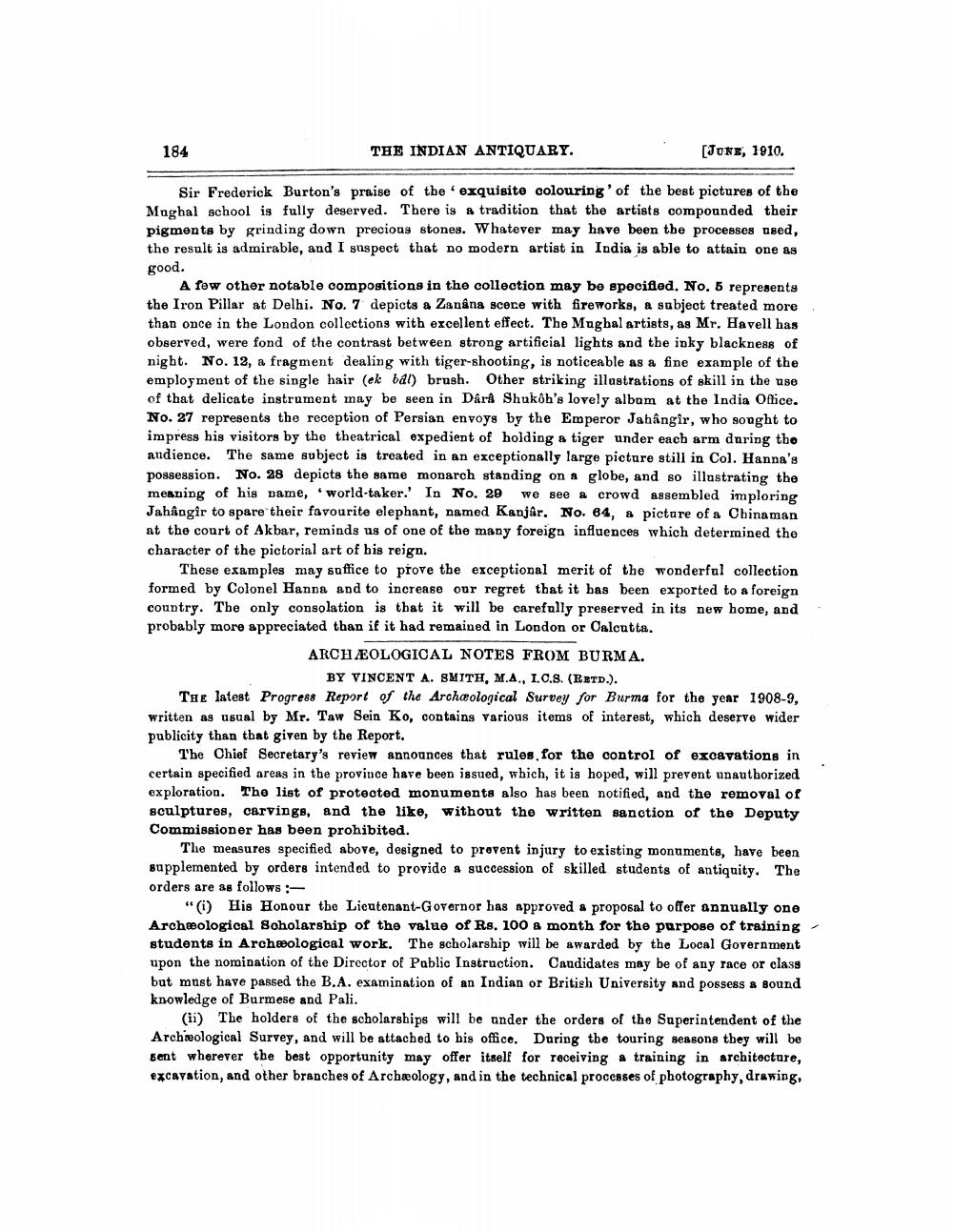________________
184
THE INDIAN ANTIQUARY.
[JUNE, 1910.
Sir Frederick Burton's praise of the exquisite colouring' of the best pictures of the Moghal school is fully deserved. There is a tradition that the artists compounded their pigments by grinding down precious stones. Whatever may have been the processes osed, the result is admirable, and I suspect that no modern artist in India is able to attain one as good.
A few other notable compositions in the collection may be specified. No. 5 represents the Iron Pillar at Delhi. No. 7 depicts a Zanâna scece with fireworks, a subject treated more than once in the London collections with excellent effect. The Mughal artists, as Mr. Havell has observed, were fond of the contrast between strong artificial lights and the inky blackness of night. No. 12, a fragment dealing with tiger-shooting, is noticeable as a fine example of the employment of the single hair (ek bal) brush. Other striking illustrations of skill in the use of that delicate instrument may be seen in Dard Shukôh's lovely albam at the India Office. No. 27 represents the reception of Persian envoys by the Emperor Jahangir, who sought to impress his visitors by the theatrical expedient of holding a tiger under each arm during the audience. The same subject is treated in an exceptionally large picture still in Col. Hanna's possession. No. 28 depicts the same monarch standing on a globe, and so illustrating the meaning of his name, 'world-taker.' In No. 29 we see a crowd assembled imploring Jahangir to spare their favourite elephant, named Kanjár. No. 84, a picture of a Chinaman at the court of Akbar, reminds us of one of the many foreign influences which determined the character of the pictorial art of his reign.
These examples may soffice to prove the exceptional merit of the wonderful collection formed by Colonel Hanna and to increase our regret that it has been exported to a foreign country. The only consolation is that it will be carefully preserved in its new home, and probably more appreciated than if it had remained in London or Calcutta.
ARCHÆOLOGICAL NOTES FROM BURMA.
BY VINCENT A. SMITH, M.A., 1.C.S. (RETD.). The latest Progress Report of the Archeological Survey for Burma for the year 1908-9, written as usual by Mr. Taw Sein Ko, contains various items of interest, which deserve wider publicity than that given by the Report.
The Chief Secretary's review announces that rules for the control of excavations in certain specified areas in the province have been issued, which, it is hoped, will prevent unauthorized exploration. The list of protected monuments also has been notified, and the removal of sculptures, carvings, and the like, without the written sanction of the Deputy Commissioner has been prohibited.
The measures specified above, designed to prevent injury to existing monuments, have been supplemented by orders intended to provide a succession of skilled students of antiquity. The orders are as follows:
"() His Honour the Lieutenant-Governor has approved a proposal to offer annually one Archeological Scholarship of the value of Rs. 100 a month for the purpose of training students in Archeological work. The scholarship will be awarded by the Local Government upon the nomination of the Director of Pablic Instruction. Candidates may be of any race or class but must have passed the B.A. examination of an Indian or British University and possess a sound knowledge of Burmese and Pali.
(ii) The holders of the scholarships will be under the orders of the Superintendent of the Archäological Survey, and will be attached to his office. During the touring seasons they will be sent wherever the best opportunity may offer itself for receiving a training in architecture, excavation, and other branches of Archæology, and in the technical processes of photography, drawing,




